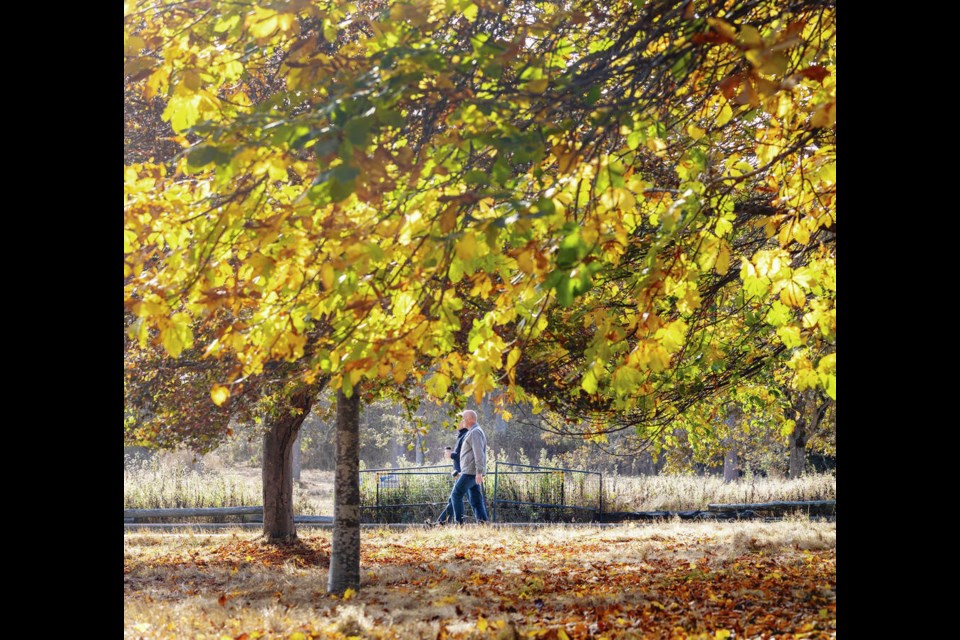A record drought that has taken a heavy toll on mushrooms this fall on many parts of Vancouver Island may not have hurt the deadliest of them all.
Death cap mushrooms, Amanita phalloides, live off host trees and are commonly found on city boulevards and lawns, and in parks throughout the capital region — places where they’re most likely to be aided by human watering and not the late summer and autumn rains that typically feed other species.
Mycologist Andy MacKinnon said flushes of death caps were reported in August and September in Greater Victoria, and with recent rains, their numbers could proliferate.
“Even in dry years like this, we will see … the death cap simply because they have been getting the moisture by watering,” said MacKinnon. “The rains we’ve had … we could see more. I wouldn’t be surprised.”
He said it’s a reminder to be extra cautious when picking, especially since other species of fungi are late or simply will not appear after the drought.
The deadly mushroom found its way to Victoria attached to the roots of ornamental European hardwoods that were imported about 50 years ago and has typically been seen around English oaks, chestnuts, lindens and hornbeams planted on boulevards, around homes and in parks . But it has since adapted to be hosted by pines and Garry oaks.
Threads of the fungi travel underground via complex and intertwining root systems, while spores travel through the air. The spread of the death cap in Greater Victoria and as far north as Galiano Island and Courtenay has prompted Island Health and municipalities to issue public warnings.
Two years ago, a warning was issued after large patches of death cap were found in Comox. In 2016, a three-year-old Victoria boy died after ingesting death caps gathered from a Victoria boulevard, while in 2003, an Oak Bay resident barely survived after cooking and eating death caps that he thought were puffballs.
Island Health said up to 30 per cent of people who eat a death cap will die, and “liver transplants are a necessary life-saving procedure.” Early treatment in hospital is essential.
The City of Victoria parks department limits watering of boulevards, focusing on new tree plantings, a spokeswoman said Monday. Parks staff also keep track of where death caps are found and continue to monitor the sites.
Until rain started falling on the weekend, Greater Victoria had experienced the driest 90-day period in its recorded history, while areas such as Courtenay, Duncan and Port Alberni have received less than 3% of their typical autumn rainfalls.
That’s made it difficult for mushroom hunters, pickers and commercial sellers to find many species of fungi during what is usually mushroom season — from September through October.
Fewer species are making appearances this fall and the numbers of mushrooms are few and far between, said mycologist Kem Luther.
Luther said he has been attending and guiding mushroom festivals over the past month — most recently last weekend around Cowichan — and searchers are so far discovering only 70% of the species typically seen at this time in any other year.
“The variety is still out there,” said Luther. “It’s the quantity that’s missing … you have to look very hard to find them.”
A mushroom event on the mid-Island last weekend turned up no mushrooms at all, although others in the fog belt around Port Renfrew and Tofino and in mountain areas like Whistler have had better luck, said Luther.
MacKinnon said the massive mycelium mats made up of long, super-thin filaments called hyphae are still alive — they just don’t have the moisture to produce mushrooms.
“It’s like an apple tree that doesn’t produce apples one year. The tree is still photosynthesizing, still being active, but not sharing many nutrients to help the mushrooms.”
Fungi don’t produce their own nutrition, but act as essential go-betweens.
Mycorrhizal fungi form associations with trees and other plants and help them grow. A tree sends sugars produced in photosynthesis to its roots for fungi to use. In return, fungi absorb minerals and water from the soil and deliver them to the roots.
Decomposer mushrooms are typically smaller, and many aren’t actually visible, and live on rotting materials and recycle nutrients for new generations of plants.
MacKinnon said he isn’t too concerned about the health of decomposer fungi through the drought, but is worried about the mycorrhizal fungi that produce larger fruits and live off trees.
“The tree partners that feed them have been having trouble over the dry periods, with less sugars to spare their partners,” he said, resulting in smaller or no mushrooms at all.
>>> To comment on this article, write a letter to the editor: [email protected]



